Hi Peter, I’m also looking forward to following your build. Your introductory posts have piqued my interest.
You are using an out of date browser. It may not display this or other websites correctly.
You should upgrade or use an alternative browser.
You should upgrade or use an alternative browser.
HMS Victory - Caldercraft-Jotika - 1/72. Build log
- Thread starter PeterG
- Start date
- Watchers 50
-
- Tags
- caldercraft jotika victory
- Joined
- Jun 13, 2022
- Messages
- 237
- Points
- 143

Looking forward to following your build ...The time has come to embark on my NEW build - The HMS Victory using the POF wood kit of Caldercraft (Jotika). As most would know, HMS Victory remains one of the most 'modelled' of all model ships. Like the ship Vasa, it exists today, can be physically touched/seen and examined (albeit currently undergoing a MAJOR restoration at Portsmouth with an estimated £45m price tag - Refer to the Royal Navy site here).
View attachment 413224
One of the other benefits of having the physical ship existing is that there is a plethora of research material, books, plans and people available to ask questions, not only here at SOS but also the British Royal Navy Conservation foundation where a detailed Conservation Log is being provided - A bit like a Build Log only applicable to the REAL ship!!).
My Build Log here commenced as a gift I received while completing my Vasa model about half way through the 'Covid years' from The Admiral. With transition from work to retirement, plus the Covid lockdowns and also maintaining a working farm (in the reaches of the Snowy Mountains of southeast New South Wales, Australia), my time was limited to commence the build, but things have cleared a little now and I have some time, so the start has begun. As is my habit, I like to approach things carefully and so with a bit of research, and after a few searches of this forum (SOS), I noticed that although there are MANY entries and Build Logs for the Victory, strangely, there are actually not many describing the Caldercraft 1/72 wooden kit on Ships of Scale. To illustrate this, on the recently provided Index of Wooden Ships, there are 124 Victory build entries (or similar). Of these 124, there are SEVEN which I can find that are specifically related to the Caldercraft Kit and of these only 5 are actual Build Logs!!
One of these by Hoss6262, exceptionally describes the entire kit, its 15 kg of enclosed material and all the exceptionally well prepared cut-out sheets etc. This is an expensive kit, but you pay for what you get. The quality is excellent, the parts fit together with very tight tolerances (and in some cases, too tight, as I will explain) and I have no complaint about the professionalism in preparing this kit. Even registration of the kit with the manufacturers, Jotika, brings benefits if parts require replacement or updating.
View attachment 413225
One of the other Build Logs (plus a comprehensive set of Youtube videos) has been provided by Paul1958 (a fellow Aussie!!) and this has proved to be exceptionally useful. I will not attempt to emulate Paul's excellent work, but on the way through the build, I will refer to his work, but also add a number of observations and comments of my own which might assist following builders.
So to start. I commenced by substantially modifying my 'workshop dry dock' after the Vasa build, to accommodate this bigger build and larger ship (both in scale and overall size). One of the things I did was change around the build area which meant I had the luxury of TWO desks with a 1.0 metre gap in the middle with a swivel chair, and the 'build desk', being an extended kitchen bench top that was considerably longer than the model, but which also allowed me to access the ship on BOTH sides. However as an added advantage (and one I found exceptionally useful with the Vasa build), was the use of a baseboard with keel clamps (similar to Paul1858's dock), but mounted on a large 'Lazy Susan'. A Lazy Susan is a circular, roller bearing mounted 'plate' which can be easily and cheaply purchased (Google 'Lazy Susan'). A Lazy Susan is a turntable (rotating tray) placed on a table or countertop to aid in distributing food, but in our case, provides the ability to simply rotate our baseboard-mounted ship which can then be rotated easily around the vertical axis.
A little unconventionally, but a good place to start, I wanted to eventually mount the Victory on a baseboard for display. The Manual describes the use of three 1/8" brass rods, drilled into the central keel area where brass rods can be inserted to mount the finished ship. I wanted something a little more sturdy, and so in the keel, I drilled three holes but then mounted three cross-threaded round push-through nuts (as obtained and used from Ikea furniture), and these then allowed me to insert thin screws (size M5), and actually bolt down the ship once mounted.
View attachment 413226
I reinforced these nuts with additional 5mm ply (making sure their placement did not interfere with the bulkheads on either side, and this allows a VERY rigid and firm securing of the model along its keel. Note in the photo above too, I have already chamfered the base ends of the keel as described on Plan 2 of the kit. This MUST be done early in the build, and I recommend it be done BEFORE placing any bulkheads as it means you are working on a flat surface to sand and Dremel machine off the required chamfer. I ALSO recommend that you LEAVE OFF the stern walnut keel extension and base keel at this time. The stern walnut will be applied later when the planking is completed to make a neat and clean finish, but the base keel stern walnut piece can be left until just before first planking. So, the mounted centre keel/spine is as shown below. Note the three mounting nuts, plus the bracket supports (as used by Paul1958 in his first Youtube video).
View attachment 413227
The NEXT stage is the placement of the bulkheads. I will leave this to the next build log entry.
Regards,
PeterG
Expended hours: 32 hours.
After wiring up for the middle deck, and testing, I placed the outer plywood patterns with the gun ports in place for the middle and lower gun decks (using pins and clamps). Hmmmm, here is where I met a quandary. With the extra lighting inside and highlighting the internal cannon bays, I am now going to have to add additional internal details. The lighting allows a view internally that people are definately going to look in to. For example, the lower two cannon decks use 'dummy' cannons and these look very obvious with the LED lights inside. Similarly, the floors will need to appear to have planking in the cannon bays. The floors are not a problem as its simple to glue some correctly cut and planked bases. The cannons are however an issue, as I am going to have to construct some 'false' cannon trucks, which from the outside will appear 'real'. This will take some time and will have to be done for about 60 dummy cannons on the lower and middle decks!! On decks above this, cannon trucks are part of the kit yet to be constructed.
Peter, I have a suggestion for lighting with LEDs to hide the "dummy"cannons.
The black paint inside the cannon bay is to avoid light reflections and give a greater sensation of "depth" , highlighting only the half cannon that you want to show. If you install the LEDs in the bulkheads , very close to the hull, the source of light will diffused and unnoticeable to anyone observing from the outside, trough the cannon doors.
I suggest a test, temporarily installing two or three 1/2 cannons, and using paper ( dark ) in place of the planking, cutting out the doors holes, to close the cannon bay.
I think it will work.
Nice to see another CC underway. It's a joy to build . I have not done much for the past 12 months or so as adding the copper plates got a little tedious and I got distracted with other hobbies. I've got about 500 to go out of the 3000 added. Just have to re motivate myself, but is summer here and the beers calling..
Great work.
Great work.
Peter, enjoying your build so far. You are in for an enjoyable journey. I had posted my earlier build steps under the postThank you Paul (dockattner) and Adiefenbach. I would love to see some pictures of your build Adiefenbach - It sounds intriguing. You are also correct with reading the Manual plus importantly, reading a few pages in advance. I have also found the book (and I have a few on Victory), which is "The New Period Ship Handbook". This gives step-by-step build comments but from a builder's perspective and following along with the kit Manual for the Victory but also a range of other ships such as the Endeavour, The Bounty and Agamemnon. (amongst others).
View attachment 413939
Now I was wanting to introduce some lighting within the hull of the ship, and this could really only effectively be done while the hull was unplanked. As we move higher, access is a little easier as it can be installed sequentially before upper decks go on (and so hide the wiring). I was keen to have a 'period' source for the lighting and with a little research on Google, it now turns out that for very cheap cost, you can buy online, yellow/white FLICKERING LEDs which for my purpose look like candles/wick lanterns when their light brightens and dims randomly. Turns out they were only a few cents each and when wired on to a 'test breadboard', gave an excellent light.
LED BACKGROUND
A little bit of knowledge and background is required to wire up LEDs, but anyone can do it. The LED is a light device which is a diode and therefore passes current only one way. Hence a positive and negative (cathode and anode) rule has to be applied when connecting to a power source. The LEDs I was using were rated at 3 Volt and 25 milliAmps (or 0.025 Amps). LEDs are also a 'current' device, so that once their 3V threshold is provided, they will light up, and then draw current to illuminate. An excess of voltage beyond 3 volts however (and this must be DIRECT CURRENT, and I chose a 12 volt power source), will overload the LEDs and cause them to burn out. Therefore to limit the voltage going to the LEDs, a resistance is required to reduce the voltage to the correct value. This resistance can be calculated by the formula:
Resistance (ohms) = (Vs - Vf) / LED forward current (Amps) where Vs is the source voltage 12v) and the Vf is the LED rated voltage (3V), so for my example,
= (12 - 3) / 0.025 = 360 ohms. The safest nearest standard resistor value is 390 ohms.
There are also a wide range of LED Resistance Calculators which can do the sum for you (for example, here).
Also, LEDs can be wired in series or parallel. In the case of wiring the hull, it is a simple matter to run two wires the length of each side of the ship (which act as 'bus' connections for parallel wiring of the LEDs). These wires can be near the cannon bays, then by drilling two holes at the back of the cannon bay, the LED can be inserted, and the two wires soldered to the POSITIVE wire (including a 390 ohm resistor), and then the anode of the LED connected to the NEGATIVE wire such that polarity is provided. This parallel wiring allows for a LOT of LEDs to be connected to the 'bus' wiring running through the hull. The power source gets a connection at the stern of the ship and then can be extended to lie outside the ship with 'hidden' wiring to the main supply transformer (delivering 12 volt DC with rated 2.5 Amp current), which should be sufficient for up to about 60 LEDs. The diagram below gives you an idea of the circuit with the two vertical lines on the left and right side acting as the 'bus' wires duplicated around each inside of the hull.
View attachment 414112
In the circuit above, I have shown 10 LEDs but this can be extended to many more. Below is a picture of the hull with the Lower Deck in place and you can see the RED (positive) bus which weaves in and out of the bulkheads down the length of both sides of the ship.
View attachment 414113
Also running down the inside on top of the dummy cannon wall is a bare copper wire to act as the earth or NEGATIVE bus. I have left this wire bare as it makes the soldering in tight spaces easier. The next picture shows the resistors and LEDs in place and the second picture with four LEDs connected and operating.
View attachment 414115View attachment 414114
I have experimented here to test whether I prefer the LED to be mounted horizontally or vertically. I think the vertical mounting is better, as it more subtly displays the light and it looks more like an internal lamp/lantern hanging from the deck above. Note too, that I have added in a thin flat base of stained balsa. This looks better to me than the black, but I also do not think I will place LEDs at EVERY cannon bay - only a select few (say 7-8 along each deck level).
After wiring up for the middle deck, and testing, I placed the outer plywood patterns with the gun ports in place for the middle and lower gun decks (using pins and clamps). Hmmmm, here is where I met a quandary. With the extra lighting inside and highlighting the internal cannon bays, I am now going to have to add additional internal details. The lighting allows a view internally that people are definately going to look in to. For example, the lower two cannon decks use 'dummy' cannons and these look very obvious with the LED lights inside. Similarly, the floors will need to appear to have planking in the cannon bays. The floors are not a problem as its simple to glue some correctly cut and planked bases. The cannons are however an issue, as I am going to have to construct some 'false' cannon trucks, which from the outside will appear 'real'. This will take some time and will have to be done for about 60 dummy cannons on the lower and middle decks!! On decks above this, cannon trucks are part of the kit yet to be constructed.
If I just construct some balsa vertical truck sides and a base of the right proportions (no wheels or ropes etc), I think I can get away with it. I will play around and see how I go.
I came across one other builder (robipod who is on MSW), who has dealt with the above internal view problem quite differently. He has gone to the extent of using Victory internal photos and with CorelDraw, fashioned individual cannon bay inserts using photographic paper, then sticking these around the internal walls of each cannon bay - A very interesting idea (see photos below - With full appreciation and thanks to robipod for using his method). Definately food for thought.
View attachment 414120
Regards,
PeterG
Elapsed Time = 92 hours
"My swing at Caldercraft HMS Victory". think it is still accessible on this site. I have included some shots of where I am today. Fore mast installed, Main mast in progress, mizzen waiting, and rigging in the distance. As I mentioned earlier, looking ahead is always a good idea. The latest instance for me was completing the assembly of the Fore mast, with glue, and then remembering the great article by Don Driskell on rigging that strongly recommends installing all the shrouds on the lower mast section before gluing up the upper masts to the structure. Too late to follow that sage advice on my fore mast but will catch it on the main and following. Live and learn. Anyway, think you are making great progress and your work looks fantastic.
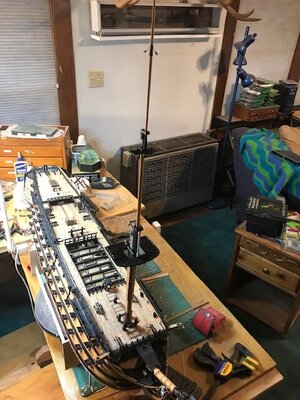
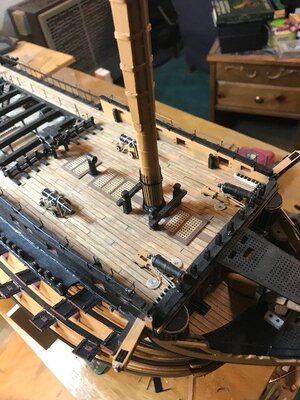
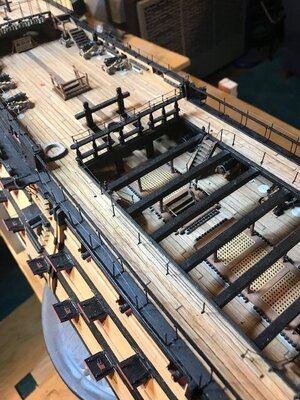
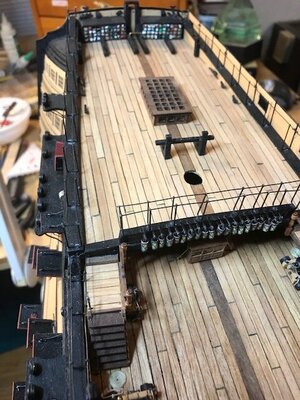
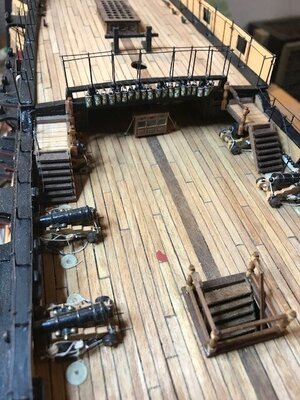
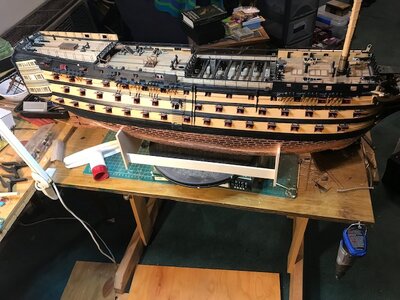
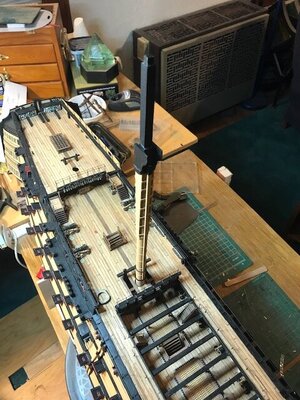
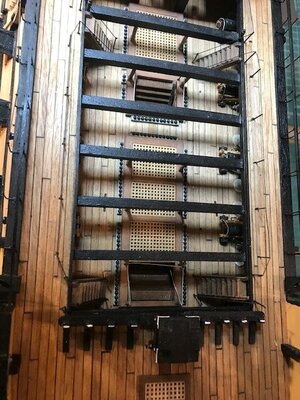
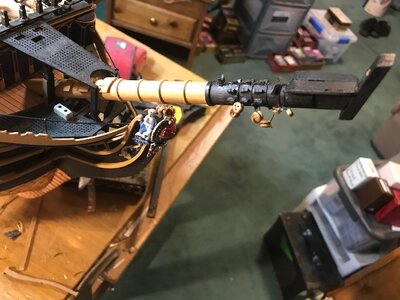
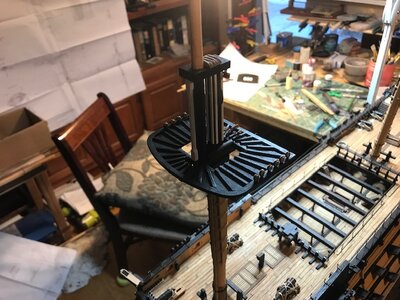










That's my favoured method of mounting my ships, using cross dowels.The time has come to embark on my NEW build - The HMS Victory using the POF wood kit of Caldercraft (Jotika). As most would know, HMS Victory remains one of the most 'modelled' of all model ships. Like the ship Vasa, it exists today, can be physically touched/seen and examined (albeit currently undergoing a MAJOR restoration at Portsmouth with an estimated £45m price tag - Refer to the Royal Navy site here).
View attachment 413224
One of the other benefits of having the physical ship existing is that there is a plethora of research material, books, plans and people available to ask questions, not only here at SOS but also the British Royal Navy Conservation foundation where a detailed Conservation Log is being provided - A bit like a Build Log only applicable to the REAL ship!!).
My Build Log here commenced as a gift I received while completing my Vasa model about half way through the 'Covid years' from The Admiral. With transition from work to retirement, plus the Covid lockdowns and also maintaining a working farm (in the reaches of the Snowy Mountains of southeast New South Wales, Australia), my time was limited to commence the build, but things have cleared a little now and I have some time, so the start has begun. As is my habit, I like to approach things carefully and so with a bit of research, and after a few searches of this forum (SOS), I noticed that although there are MANY entries and Build Logs for the Victory, strangely, there are actually not many describing the Caldercraft 1/72 wooden kit on Ships of Scale. To illustrate this, on the recently provided Index of Wooden Ships, there are 124 Victory build entries (or similar). Of these 124, there are SEVEN which I can find that are specifically related to the Caldercraft Kit and of these only 5 are actual Build Logs!!
One of these by Hoss6262, exceptionally describes the entire kit, its 15 kg of enclosed material and all the exceptionally well prepared cut-out sheets etc. This is an expensive kit, but you pay for what you get. The quality is excellent, the parts fit together with very tight tolerances (and in some cases, too tight, as I will explain) and I have no complaint about the professionalism in preparing this kit. Even registration of the kit with the manufacturers, Jotika, brings benefits if parts require replacement or updating.
View attachment 413225
One of the other Build Logs (plus a comprehensive set of Youtube videos) has been provided by Paul1958 (a fellow Aussie!!) and this has proved to be exceptionally useful. I will not attempt to emulate Paul's excellent work, but on the way through the build, I will refer to his work, but also add a number of observations and comments of my own which might assist following builders.
So to start. I commenced by substantially modifying my 'workshop dry dock' after the Vasa build, to accommodate this bigger build and larger ship (both in scale and overall size). One of the things I did was change around the build area which meant I had the luxury of TWO desks with a 1.0 metre gap in the middle with a swivel chair, and the 'build desk', being an extended kitchen bench top that was considerably longer than the model, but which also allowed me to access the ship on BOTH sides. However as an added advantage (and one I found exceptionally useful with the Vasa build), was the use of a baseboard with keel clamps (similar to Paul1858's dock), but mounted on a large 'Lazy Susan'. A Lazy Susan is a circular, roller bearing mounted 'plate' which can be easily and cheaply purchased (Google 'Lazy Susan'). A Lazy Susan is a turntable (rotating tray) placed on a table or countertop to aid in distributing food, but in our case, provides the ability to simply rotate our baseboard-mounted ship which can then be rotated easily around the vertical axis.
A little unconventionally, but a good place to start, I wanted to eventually mount the Victory on a baseboard for display. The Manual describes the use of three 1/8" brass rods, drilled into the central keel area where brass rods can be inserted to mount the finished ship. I wanted something a little more sturdy, and so in the keel, I drilled three holes but then mounted three cross-threaded round push-through nuts (as obtained and used from Ikea furniture), and these then allowed me to insert thin screws (size M5), and actually bolt down the ship once mounted.
View attachment 413226
I reinforced these nuts with additional 5mm ply (making sure their placement did not interfere with the bulkheads on either side, and this allows a VERY rigid and firm securing of the model along its keel. Note in the photo above too, I have already chamfered the base ends of the keel as described on Plan 2 of the kit. This MUST be done early in the build, and I recommend it be done BEFORE placing any bulkheads as it means you are working on a flat surface to sand and Dremel machine off the required chamfer. I ALSO recommend that you LEAVE OFF the stern walnut keel extension and base keel at this time. The stern walnut will be applied later when the planking is completed to make a neat and clean finish, but the base keel stern walnut piece can be left until just before first planking. So, the mounted centre keel/spine is as shown below. Note the three mounting nuts, plus the bracket supports (as used by Paul1958 in his first Youtube video).
View attachment 413227
The NEXT stage is the placement of the bulkheads. I will leave this to the next build log entry.
Regards,
PeterG
Expended hours: 32 hours.
Thank you Uwek for that additional information on the book.
Thanks also to Gilbertm, Grant, Chestcutter, Hoss6262, Spars, WojtasS, Lobo and MarcMarseille. It is one of the pleasant aspects of Ships of Scale and this Forum to have so many people follow your build. With Christmas and New Year (Happys and Merrys everybody!!) time to advance the build will be a little limited but I will try and get a few entries here.
After the problem I highlighted with the lack of internal Victory detail which is likely to be seen through the Lower and Middle decks cannon ports, I have decided to add 'floors' to each cannon bay (behind the gun ports), and to do this I have used some thin (1 mm) balsa and inscribed some planking using a dark lead pencil using parallel lines to simulate the planking width.
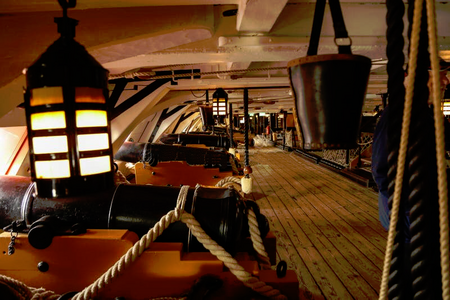
I have then created some 'dummy cannon trucks'. These I have simply made of balsa which go either side of the dummy barrels and will look like trucks from the outside. I will post a picture when this is done to show the effect. This is probably 'overkill' but the internal lighting has brought this on myself. It should only take a couple of days work and hopefully will be effective when completed.
Regards,
PeterG
Thanks also to Gilbertm, Grant, Chestcutter, Hoss6262, Spars, WojtasS, Lobo and MarcMarseille. It is one of the pleasant aspects of Ships of Scale and this Forum to have so many people follow your build. With Christmas and New Year (Happys and Merrys everybody!!) time to advance the build will be a little limited but I will try and get a few entries here.
After the problem I highlighted with the lack of internal Victory detail which is likely to be seen through the Lower and Middle decks cannon ports, I have decided to add 'floors' to each cannon bay (behind the gun ports), and to do this I have used some thin (1 mm) balsa and inscribed some planking using a dark lead pencil using parallel lines to simulate the planking width.

I have then created some 'dummy cannon trucks'. These I have simply made of balsa which go either side of the dummy barrels and will look like trucks from the outside. I will post a picture when this is done to show the effect. This is probably 'overkill' but the internal lighting has brought this on myself. It should only take a couple of days work and hopefully will be effective when completed.
Regards,
PeterG
I built dummy carts for the dummy guns on my Vasa so I affirm this choice! And, as you say, the lighting makes this especially necessary. Love the way you think things through Peter!Thank you Uwek for that additional information on the book.
Thanks also to Gilbertm, Grant, Chestcutter, Hoss6262, Spars, WojtasS, Lobo and MarcMarseille. It is one of the pleasant aspects of Ships of Scale and this Forum to have so many people follow your build. With Christmas and New Year (Happys and Merrys everybody!!) time to advance the build will be a little limited but I will try and get a few entries here.
After the problem I highlighted with the lack of internal Victory detail which is likely to be seen through the Lower and Middle decks cannon ports, I have decided to add 'floors' to each cannon bay (behind the gun ports), and to do this I have used some thin (1 mm) balsa and inscribed some planking using a dark lead pencil using parallel lines to simulate the planking width.
View attachment 414636
I have then created some 'dummy cannon trucks'. These I have simply made of balsa which go either side of the dummy barrels and will look like trucks from the outside. I will post a picture when this is done to show the effect. This is probably 'overkill' but the internal lighting has brought this on myself. It should only take a couple of days work and hopefully will be effective when completed.
Regards,
PeterG
Peter, I am excited in following your build, should be a lot of fun! I just opened a Fosters and pulling up a stool! Magic Mike
Almost too many of you to thank for following my build. To you all, many thanks, Merry Christmas and Happy New Year. To answer some of your questions:
Lobo - I hope my lighting notes help you. To my mind, its all in the planning and thinking ahead. Once the ship gets closed in by planking (in my case), it becomes almost impossible to run the wiring. The use of 'buses' or 'rails' make the job much easier, but they still have to cover areas which may be difficult to access, so plan ahead. I look forward to seeing some detail of your results.
Adiefenbach - Many thanks for posting these photos. I was curious with your progress given that we have the same Caldercraft kit. You work is inspirational and I would again like to see additional images as you progress. How long has it taken you to get to this point?
Also, am I correct in that you are using a rotatable stage, (as am I) with a Lazy Susan. I find it absolutely essential, but provides strong, safe and steady access to both sides of the ship quickly and easily - and this is a BIG ship.
Paul - (Dockattner) - As Uhtred says in The Last Kingdom, 'Destiny is All'. Well in shipbuilding, 'Planning Ahead is All'!! If you haven't seen this TV movie series, I highly recommend it. Interestingly, we began watching the series because I was researching our family tree. It turns out that my wife is directly related to Alfred the Great (who features in the series), so it was of direct interest.
Paulv1958 - Many thanks for calling by. I note you are in East Melbourne, Victoria. I am in the Snowy Mountains just over the NSW border. I wonder if you realise just how useful your videos are and have become, not only to me but to other builders who I know have made comment on them. They are detailed, accurate and cover the 'critical' aspects of the Caldercraft build for Victory. As you say, the copper plating is a long and tedious process with 3,000-odd copper plates. This is probably the stage I am least looking forward to. I will probably have some questions for you when confronted by this, if that's OK. Meanwhile, push on if time etc permit - I need to see your next YouTube entry!!
Luiz B.F Grazi - Many thanks for your comments regarding the 'backlighting' of the LEDs and positioning. This is a good idea and I will attempt it. As I described the LEDS, I mentioned that the LEDs I am using are a bit 'special'. In each yellow LED, there is a chip embedded which will make the light 'flicker' like a candle or lantern (as used in the ship). As such, I was keen for the LED light to be visible through the gun port. However, that said, what you suggest is worth experimenting with, so I will give it a try and let you know.
Part of the LED placement and the cannon bay set up for the 'dummy trucks' and dummy cannons has required I position these before finally gluing the side patters to the bulwarks, which is the next stage of the build. To do this I have clamped the patterns temporarily in position and drilled the dummy gun placements. This then allows me to fit the gun trucks without having to work through the gun port openings as these were only temporarily positioned and removable.
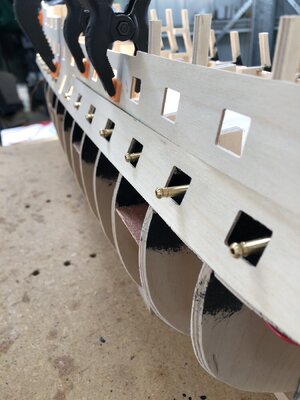
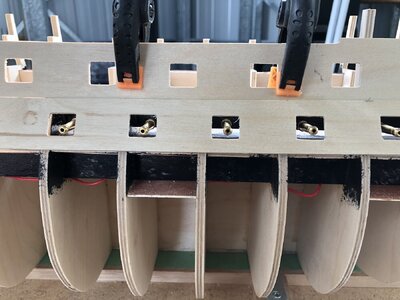
In the above pictures, nothing is glued and the cannons are removable (for blackening etc.). The next stage is to fix the upper Gun Deck pattern, with the Middle Gun Deck pattern removed and then start fitting the large number of gun trucks. False 'planked' floors for each gun bay have already been fitted.
Today, I permanently fitted and glued the upper deck pattern to the port side of the ship and am letting the glue set overnight. Note that I have removed the Middle Deck pattern timber while doing this. I will start fitting the dummy cannon trucks next. I have already created these out of 2 mm balsa wood and painted them (all 56 of them)!!
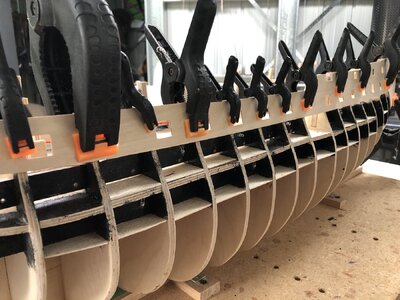
Many thanks to all who have commented.
Best Regards,
PeterG
Elapsed Time: 125 Hours
Lobo - I hope my lighting notes help you. To my mind, its all in the planning and thinking ahead. Once the ship gets closed in by planking (in my case), it becomes almost impossible to run the wiring. The use of 'buses' or 'rails' make the job much easier, but they still have to cover areas which may be difficult to access, so plan ahead. I look forward to seeing some detail of your results.
Adiefenbach - Many thanks for posting these photos. I was curious with your progress given that we have the same Caldercraft kit. You work is inspirational and I would again like to see additional images as you progress. How long has it taken you to get to this point?
Also, am I correct in that you are using a rotatable stage, (as am I) with a Lazy Susan. I find it absolutely essential, but provides strong, safe and steady access to both sides of the ship quickly and easily - and this is a BIG ship.
Paul - (Dockattner) - As Uhtred says in The Last Kingdom, 'Destiny is All'. Well in shipbuilding, 'Planning Ahead is All'!! If you haven't seen this TV movie series, I highly recommend it. Interestingly, we began watching the series because I was researching our family tree. It turns out that my wife is directly related to Alfred the Great (who features in the series), so it was of direct interest.
Paulv1958 - Many thanks for calling by. I note you are in East Melbourne, Victoria. I am in the Snowy Mountains just over the NSW border. I wonder if you realise just how useful your videos are and have become, not only to me but to other builders who I know have made comment on them. They are detailed, accurate and cover the 'critical' aspects of the Caldercraft build for Victory. As you say, the copper plating is a long and tedious process with 3,000-odd copper plates. This is probably the stage I am least looking forward to. I will probably have some questions for you when confronted by this, if that's OK. Meanwhile, push on if time etc permit - I need to see your next YouTube entry!!
Luiz B.F Grazi - Many thanks for your comments regarding the 'backlighting' of the LEDs and positioning. This is a good idea and I will attempt it. As I described the LEDS, I mentioned that the LEDs I am using are a bit 'special'. In each yellow LED, there is a chip embedded which will make the light 'flicker' like a candle or lantern (as used in the ship). As such, I was keen for the LED light to be visible through the gun port. However, that said, what you suggest is worth experimenting with, so I will give it a try and let you know.
Part of the LED placement and the cannon bay set up for the 'dummy trucks' and dummy cannons has required I position these before finally gluing the side patters to the bulwarks, which is the next stage of the build. To do this I have clamped the patterns temporarily in position and drilled the dummy gun placements. This then allows me to fit the gun trucks without having to work through the gun port openings as these were only temporarily positioned and removable.


In the above pictures, nothing is glued and the cannons are removable (for blackening etc.). The next stage is to fix the upper Gun Deck pattern, with the Middle Gun Deck pattern removed and then start fitting the large number of gun trucks. False 'planked' floors for each gun bay have already been fitted.
Today, I permanently fitted and glued the upper deck pattern to the port side of the ship and am letting the glue set overnight. Note that I have removed the Middle Deck pattern timber while doing this. I will start fitting the dummy cannon trucks next. I have already created these out of 2 mm balsa wood and painted them (all 56 of them)!!

Many thanks to all who have commented.
Best Regards,
PeterG
Elapsed Time: 125 Hours
Peter, really enjoy your progress. I have been at this for about 14 months now. The only good news I can report on the copper plating is that Caldercraft provides plenty of plates. I had about 200 left over when I finally completed the rudder so don't worry if you mess up a bunch of them.Almost too many of you to thank for following my build. To you all, many thanks, Merry Christmas and Happy New Year. To answer some of your questions:
Lobo - I hope my lighting notes help you. To my mind, its all in the planning and thinking ahead. Once the ship gets closed in by planking (in my case), it becomes almost impossible to run the wiring. The use of 'buses' or 'rails' make the job much easier, but they still have to cover areas which may be difficult to access, so plan ahead. I look forward to seeing some detail of your results.
Adiefenbach - Many thanks for posting these photos. I was curious with your progress given that we have the same Caldercraft kit. You work is inspirational and I would again like to see additional images as you progress. How long has it taken you to get to this point?
Also, am I correct in that you are using a rotatable stage, (as am I) with a Lazy Susan. I find it absolutely essential, but provides strong, safe and steady access to both sides of the ship quickly and easily - and this is a BIG ship.
Paul - (Dockattner) - As Uhtred says in The Last Kingdom, 'Destiny is All'. Well in shipbuilding, 'Planning Ahead is All'!! If you haven't seen this TV movie series, I highly recommend it. Interestingly, we began watching the series because I was researching our family tree. It turns out that my wife is directly related to Alfred the Great (who features in the series), so it was of direct interest.
Paulv1958 - Many thanks for calling by. I note you are in East Melbourne, Victoria. I am in the Snowy Mountains just over the NSW border. I wonder if you realise just how useful your videos are and have become, not only to me but to other builders who I know have made comment on them. They are detailed, accurate and cover the 'critical' aspects of the Caldercraft build for Victory. As you say, the copper plating is a long and tedious process with 3,000-odd copper plates. This is probably the stage I am least looking forward to. I will probably have some questions for you when confronted by this, if that's OK. Meanwhile, push on if time etc permit - I need to see your next YouTube entry!!
Luiz B.F Grazi - Many thanks for your comments regarding the 'backlighting' of the LEDs and positioning. This is a good idea and I will attempt it. As I described the LEDS, I mentioned that the LEDs I am using are a bit 'special'. In each yellow LED, there is a chip embedded which will make the light 'flicker' like a candle or lantern (as used in the ship). As such, I was keen for the LED light to be visible through the gun port. However, that said, what you suggest is worth experimenting with, so I will give it a try and let you know.
Part of the LED placement and the cannon bay set up for the 'dummy trucks' and dummy cannons has required I position these before finally gluing the side patters to the bulwarks, which is the next stage of the build. To do this I have clamped the patterns temporarily in position and drilled the dummy gun placements. This then allows me to fit the gun trucks without having to work through the gun port openings as these were only temporarily positioned and removable.
View attachment 415192
View attachment 415193
In the above pictures, nothing is glued and the cannons are removable (for blackening etc.). The next stage is to fix the upper Gun Deck pattern, with the Middle Gun Deck pattern removed and then start fitting the large number of gun trucks. False 'planked' floors for each gun bay have already been fitted.
Today, I permanently fitted and glued the upper deck pattern to the port side of the ship and am letting the glue set overnight. Note that I have removed the Middle Deck pattern timber while doing this. I will start fitting the dummy cannon trucks next. I have already created these out of 2 mm balsa wood and painted them (all 56 of them)!!
View attachment 415194
Many thanks to all who have commented.
Best Regards,
PeterG
Elapsed Time: 125 Hours
Also, am using a rotating base that was designed for TV's I think. Plastic upper and lower discs with some bearings in between. I found it useful to drill vertical holes through both discs so that I can lock in place with a nail. Did this in two locations 180 degrees apart and marked the drilled locations with white paint so they are easy to find.Peter, really enjoy your progress. I have been at this for about 14 months now. The only good news I can report on the copper plating is that Caldercraft provides plenty of plates. I had about 200 left over when I finally completed the rudder so don't worry if you mess up a bunch of them.
- Joined
- Jun 5, 2021
- Messages
- 141
- Points
- 88

Merci pour tes vœux
Reçois de même mes meilleurs souhaits pour la nouvelle année, ainsi qu'un joyeux Noël
Marco
Thanks for your wishes
Please also receive my best wishes for the New Year and a Merry Christmas.
Marco
Reçois de même mes meilleurs souhaits pour la nouvelle année, ainsi qu'un joyeux Noël
Marco
Thanks for your wishes
Please also receive my best wishes for the New Year and a Merry Christmas.
Marco
Adienbach, that should make a good, stable rotatable base. I have a baseboard mounted on to my rotatable base and this allows me not only to turn the ship with a secured keel mount or hull frame mounts, but to have tools and parts readily available on the baseboard surface. Good news about the copper plates. I am assuming you have finished this aspect of the build - I congratulate you on your persistence!!
Thank you MarcMarseille and Morgan63 for your Christmas wishes. I trust you too (and everyone) will have a wonderful Merry Christmas and a Happy New Year.
As you could see in my previous post, below the Upper Deck pattern of the ship, lies the gun port pattern of the Middle Deck. While this butts up hard against the bottom edge of the Upper Deck pattern, it has an extension of about 50mm (2"), which is designed to wrap around the bow and join up with the upper, forward part of the keel. This pattern (like the other decks), is made of 1.5 mm plywood. In the Paulv1958 video, he soaks the front of the pattern (which is the section that has to be bent around the bow), in water and then bends it around, holding it in position with nails and a clamp. I thought this was a bit cumbersome despite this being the method described in the Manual.
So, I thought I would experiment and try a different approach. I have never bent plywood of this thickness and over such an area before, and I was concerned it may split. The idea I adopted was to get a piece of relatively soft timber scrap (I had some pine in the workshop which was 100mm x 50 mm (4" x 2")) and using a jig saw, I cut a curve closely matching the radius quadrant of the bow shape. Once cut, and with a scrap piece of 1.5mm plywood (the same material as the deck patterns), I soaked it for about 10 minutes, and inserted it in between the curved pine blocks. I then applied two clamps to lock the bending ply in place. After 2 hours of leaving this plywood test piece to retain its bend and dry out, I came out with a near perfect bend which fitted the bow curvature almost exactly (see below).
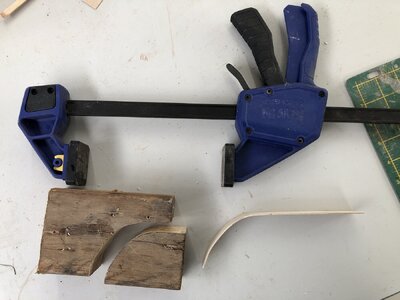
There is no tendency for the plywood to spring back but it is a close fit and so, even with a bit of minor adjustment when being fitted, it will be able to accommodate the required compound curvature which is needed for the bow placement. I then applied this same approach to the Middle Deck plywood pattern as shown below while in the clamped pine 'press'.
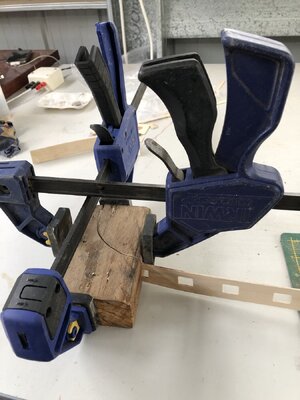
The pattern came out of the pine press again, like the test piece, perfectly shaped to fit the bow with a minimum of adjustment and no gaps when butted up against the Upper Gun Deck pattern. I will have to repeat this process for the starboard side pattern but also the Lower Deck plywood patterns. Interestingly, this method would probably also work effectively for some of tight curves required for the actual planking, but in this case, firstly the planking strips are thinner (1.0 mm thick), a lot less wide (5-6 mm), and will bend a lot quicker with the use of the hot iron and roller with template shape. For the thicker and broader plywood however, this technique worked very effectively.
Regards,
PeterG
Elapsed Time: 136 hours
Thank you MarcMarseille and Morgan63 for your Christmas wishes. I trust you too (and everyone) will have a wonderful Merry Christmas and a Happy New Year.
As you could see in my previous post, below the Upper Deck pattern of the ship, lies the gun port pattern of the Middle Deck. While this butts up hard against the bottom edge of the Upper Deck pattern, it has an extension of about 50mm (2"), which is designed to wrap around the bow and join up with the upper, forward part of the keel. This pattern (like the other decks), is made of 1.5 mm plywood. In the Paulv1958 video, he soaks the front of the pattern (which is the section that has to be bent around the bow), in water and then bends it around, holding it in position with nails and a clamp. I thought this was a bit cumbersome despite this being the method described in the Manual.
So, I thought I would experiment and try a different approach. I have never bent plywood of this thickness and over such an area before, and I was concerned it may split. The idea I adopted was to get a piece of relatively soft timber scrap (I had some pine in the workshop which was 100mm x 50 mm (4" x 2")) and using a jig saw, I cut a curve closely matching the radius quadrant of the bow shape. Once cut, and with a scrap piece of 1.5mm plywood (the same material as the deck patterns), I soaked it for about 10 minutes, and inserted it in between the curved pine blocks. I then applied two clamps to lock the bending ply in place. After 2 hours of leaving this plywood test piece to retain its bend and dry out, I came out with a near perfect bend which fitted the bow curvature almost exactly (see below).

There is no tendency for the plywood to spring back but it is a close fit and so, even with a bit of minor adjustment when being fitted, it will be able to accommodate the required compound curvature which is needed for the bow placement. I then applied this same approach to the Middle Deck plywood pattern as shown below while in the clamped pine 'press'.

The pattern came out of the pine press again, like the test piece, perfectly shaped to fit the bow with a minimum of adjustment and no gaps when butted up against the Upper Gun Deck pattern. I will have to repeat this process for the starboard side pattern but also the Lower Deck plywood patterns. Interestingly, this method would probably also work effectively for some of tight curves required for the actual planking, but in this case, firstly the planking strips are thinner (1.0 mm thick), a lot less wide (5-6 mm), and will bend a lot quicker with the use of the hot iron and roller with template shape. For the thicker and broader plywood however, this technique worked very effectively.
Regards,
PeterG
Elapsed Time: 136 hours








